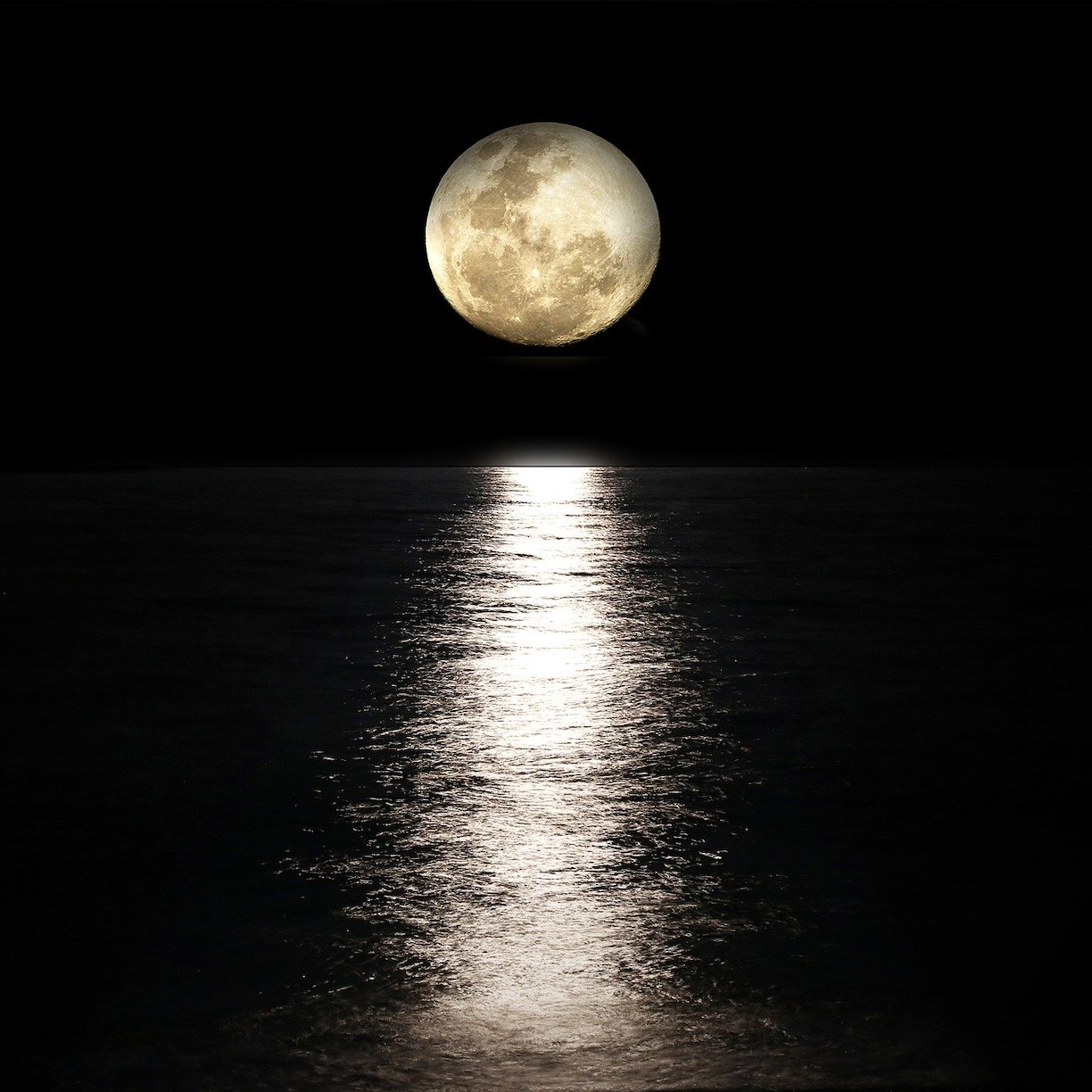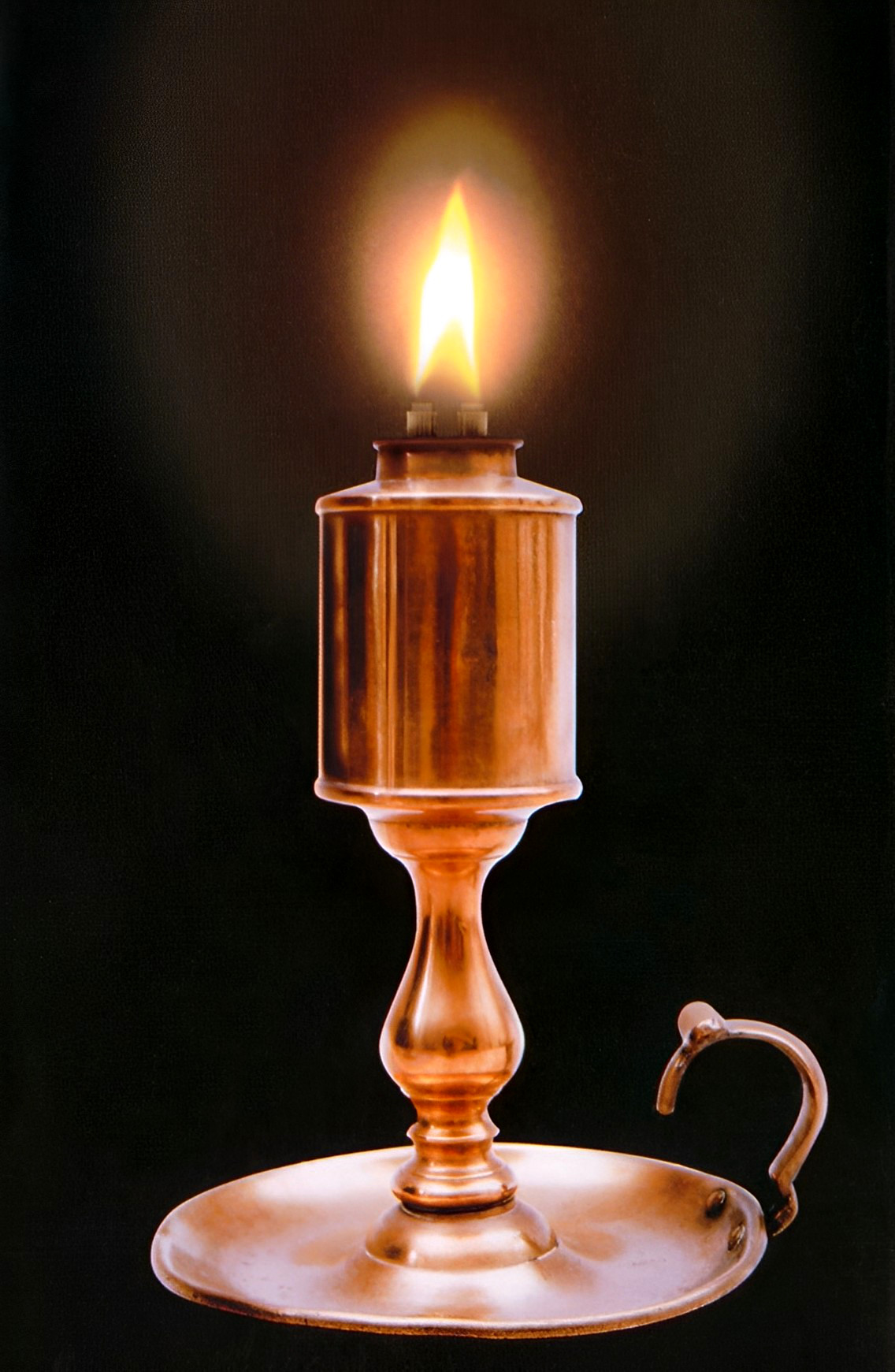
Can you imagine navigating the streets and roads of Charleston County between dusk and dawn without the aid of street lamps? The earliest inhabitants of this area relied on moonlight to guide their steps at night, but a campaign to provide nocturnal illumination commenced in the third quarter of the eighteenth century. The number of street lamps fueled by whale oil, coal gas, and electricity gradually increased over the decades, establishing the comforting but unnatural glow that now brightens the night sky.
The steady increase of light pollution over the course of the twentieth and twenty-first centuries has rendered us less familiar with the experience of total darkness. All of our distant ancestors, regardless of their place of origin, recognized the setting sun as the signal to retreat indoors or at least settle down for the night. The campfire or indoor hearth formed the epicenter of family life after sunset, aided by flickering candles and lamps commensurate with the family’s wealth or poverty. Beyond the modest glow of firelight existed a dark world of mystery and potential danger that inspired fear and superstition. The laws of ancient Europe and of early Charleston compelled urban residents to vacate the streets at sundown and remain indoors until sunrise. Rural folk were not subject to this legal curfew, but traditional habits and the lack of public amenities preserved the nocturnal darkness of rural communities until fairly recent times.
There were no public lamps illuminating the streets of Charles Town, the unincorporated capital of South Carolina, during the colony’s first century. The dark of night in the capital appeared as it did across the rest of the Lowcountry, except members of the urban Night Watch patrolled the streets of Charles Town from dusk to dawn carrying lanterns, just like their contemporaries in London and scores of other cities and towns. As the capital matured, however, citizens began to lobby the provincial legislature for street lighting to improve the safety of pedestrians and the security of the town in general.
In February 1753, for example, a member of the South Carolina Commons House of Assembly proposed the creation of a law to oblige the inhabitants of Charles Town (rather than the government) “to keep lights in the streets of the said town at certain hours in the night time.” Members of the assembly debated the topic for a just a moment before quashing the proposal. In the spring of 1761, a resident named Joseph Wilson installed at his own expense twelve lampposts at three public sites—six fronting the new State House at the northwest corner of Meeting and Broad Streets, three in front of the old Watch House at the east end of Broad Street, and three before the “Vendue House” or old exchange building at the east end of Tradd Street. Wilson personally maintained the lamps for a period of four months “to prevent the dangers & inconveniencies in dark nights arising or happening to the inhabitants of Charles Town for want of lamps placed in proper parts of the same.” He hoped members of the legislature “might see and judge of their utility & if they thought it for the public service establish a regular lamp light throughout the town.”
Christopher Gadsden, chair of a committee assigned to consider the matter, reported that “tho’ they sincerely wish so useful and ornamental an undertaking to the town could be possibly encouraged[,] yet upon consideration of the many heavy charges Charles Town is already exposed to[,] which during the [recent] Cherokee war are more likely to be encreased [sic] than lessened[,] they are obliged to be of opinion that the erecting of lamp lights should be postponed to a more favourable opportunity.”[1]
The South Carolina General Assembly in 1762 briefly entertained a bill that included a proposal “to cause lamps to be placed in proper and convenient places in the said town,” but the bill died when Governor Thomas Boone abruptly dissolved the legislature. During the years 1767 through 1770, a series of grand juries complained that the lack of public lamps in urban Charles Town was a serious concern to both residents and visitors.[2] Members of the Commons House of Assembly finally resolved in August 1769 to draft a bill “for establishing lamps in Charles Town,” but, before that bill materialized, a curious change took place.[3]
During the winter of 1769–70, a number of private citizens in the capital erected lamps in front of their own houses to “set the example to light the streets.” “Many others would have done so, at the same time,” reported the South Carolina Gazette in March 1770, but they were discouraged by the recent British duty (tax) on imported glass. Nevertheless, the collective effort demonstrated “the great utility” of the lamps, which numbered nearly a hundred by the end of winter. “And it seems to be the earnest wish of the inhabitants,” reported the newspaper, “that an act may be passed [during] the present session, for completely lighting all the streets, with such lamps as we can have made.”[4]
The private effort indeed convinced the legislature to fund the erection of a limited number of public lamps in the streets of Charles Town. In late March 1770, the Commons House ordered the provincial commissary to “agree with proper persons to erect and keep lighted at nights at the public expense” at least two dozen oil lamps, including five outside the State House, one at the door of the Watch House, one “on the south front of the Beef Market,” two “at the west front of the Exchange,” two at St. Michael’s Church, three at St. Philip’s Church, “one lamp at the prison,” one each at the French, “Dutch,” Baptist, Presbyterian, and Congregational Churches, and “one lamp at each of the places where the fire engines are kept.”[5]
Days later, on 7 April 1770, the General Assembly ratified a law for establishing a Fish Market in Charles Town, the text of which included one paragraph relating to lamps. It said nothing about erecting new lamps, but simply addressed the need to preserve and maintain those already erected by private citizens and by the provincial commissary in recent months, which were already subject to vandalism.[6] This simple act marked the beginning of public illumination that has continued and expanded over the past two-and-a-half centuries.
The principal fuel for the early street lamps was a viscous liquid derived from the flesh of whales, which came to Charleston in barrels from fishing ports in the Northern colonies. Two types of whale oil were commercially available here in the eighteenth and nineteenth centuries—spermaceti oil, a waxy liquid extracted from the head cavity of certain toothed whales, and “train oil,” an inferior product derived from boiling the fatty blubber of baleen whales. Private citizens often purchased spermaceti oil for use in small indoor lamps, while the public street lamps burned the cheaper and smellier train oil.
Sparse references to street illumination in the extant legislative records of this era include no details about the nightly routine of lighting the public lamps, but we can extrapolate useful information from later documents. From their colonial roots until the 1890s, for example, the street lamps of urban Charleston burned during twenty-four or twenty-five nights of each lunar cycle. Our forebears, who were more comfortable with darkness than twenty-first century Americans, followed an old European custom of not lighting street lamps on the night of a full moon, nor the evenings preceding and following a full moon. This monthly practice, frequently described as “following the moon,” required lamplighters and citizens alike to consult a local almanac to know when the street lamps would and would not burn. Residents complained repeatedly for more than a century about the regular inconvenience of lamp-less, pitch-black nights when clouds obscured the full moon, but our local government followed the moon every month well into the age of electricity.

In August 1783, shortly after the conclusion of the American Revolution, the South Carolina General Assembly ratified a charter to incorporate the City of Charleston and transferred to the new City Council a number of responsibilities. Maintenance and regulation of the city streets became a municipal concern at that time, and in November 1783 the city government ratified an ordinance “for the preservation of the lamps” in urban Charleston.[7] Like the colonial act of 1770, the text of the 1783 law focused on the maintenance of the existing inventory of lamps and provides no details about the number or the geographic scope of the city’s nightly illumination. Nevertheless, extant newspapers from the late eighteenth century provide confirmation of a curious practice familiar to contemporary residents.
George Ross, a tinsmith by profession, was the first lamplighter of post-war Charleston, but he did not personally walk the streets and light the oil lamps every night. Rather, he dispatched several enslaved men with ladders to do that work for him. Following his death in 1791, the Sheriff of Charleston District offered for sale “three valuable Negro fellows, who are lamp-lighters,” and belonged to the indebted estate of George Ross.[8]
His successor, Daniel Martin, deployed a similar gang of enslaved men that included a curious figure called Tom, or “Little Tom.” Standing just four feet tall and missing his front teeth, thanks to a horse’s kick, Tom pushed or dragged a cart through the streets of Charleston at dusk with a cask of whale oil, a wooden ladder, and a burning match or a pipe of tobacco. The ladder propped against a cedar lamppost enabled “Little Tom” to pour one night’s worth of oil into a reservoir encased by glass panes and light the wick with his match or pipe before moving down the street. This solitary, nocturnal labor afforded Tom a modicum of personal freedom that inspired him to run away from his master from time to time. Citizens opening their daily newspapers in mid-October 1795 read a brief, one-line notice that has stuck in my memory for years: “Tom, the lamplighter, is run away again.” Daniel Martin offered a handsome reward for the return of “Little Tom” in the spring of 1796, noting that he had been seen recently near Parker’s Ferry, but it appears that Tom’s lamp-lighting days in urban Charleston were finished.[9]
Charleston’s City Council revised its public lamp ordinance a number of times during the early decades of the nineteenth century, and surviving records document a growing inventory of oil lamps distributed across an expanding urban streetscape. In January 1830, for example, the city specified that the white contractor responsible for lighting and maintaining the street lamps was required to employ a team of no less than fifteen enslaved men to perform the nightly chores.[10] A city ordinance of November 1839 divided that work into three geographic divisions, lower, middle, and upper, which were henceforth serviced by three white contractors who deployed three teams of enslaved men every evening.[11] A report submitted to City Council in August 1840 noted the presence of 1,981 lamps within the corporate limits; that is, south of Calhoun Street, including lamps extending up King Street as far north as Line Street.[12] No surviving records indicate the preferred distance between lampposts, but later calculations provided by City Council facilitate an estimate that the antebellum oil lamps stood less than one hundred feet apart because their glow was fairly dim.
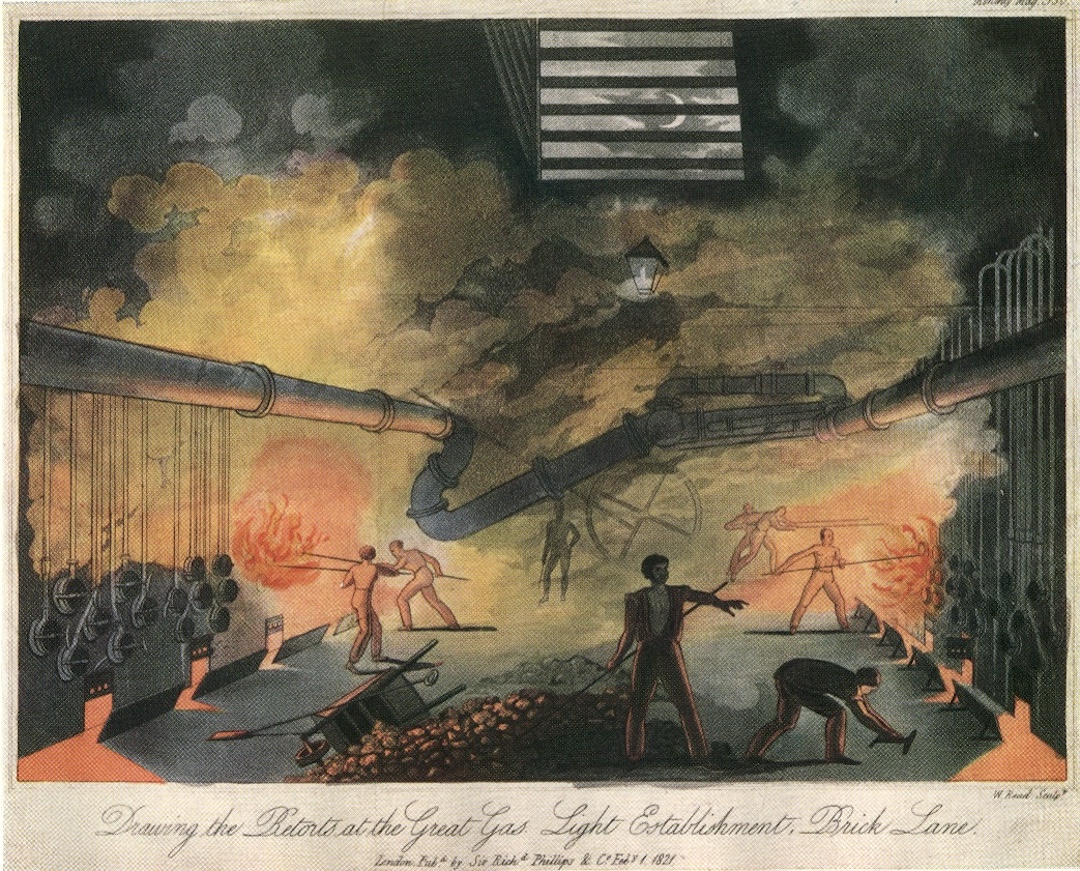
While the number of oil lamps proliferated in Antebellum Charleston, residents in other urban centers began to see a new light. The burgeoning Industrial Revolution in Europe at the turn of the nineteenth century introduced a commercial process for extracting flammable gas from ordinary coal by a process of controlled combustion. Entrepreneurs in Paris and then London demonstrated lamps illuminated by the measured burning of the invisible byproduct known as coal gas or manufactured gas. The noxious gas could be stored in huge iron drums called gasholders or gasometers and then distributed under pressure through miles of piping to customers large and small. In their rush to scale up production, investors in the new technology paid little attention to the industry’s polluting byproducts. The process of manufacturing gas from coal, or coal gasification, produced a significant volume of airborne soot as well as a viscous toxic sludge commonly called coal tar.
The City of Baltimore adopted gas lighting in 1816, followed soon thereafter by New York, Philadelphia, and other municipalities. In March 1817, Charleston’s City Council gave local architect Robert Mills a franchise to lay pipes in the city streets for a network of gas lamps. The economic depression known as the Panic of 1819 killed the project, however, and the Panic of 1837 further postponed the advent of gas light in the Palmetto City.[13]
A group of local investors organized the Charleston Gas Light Company in the winter of 1846–47 and hired a Philadelphia contractor to build a production plant at the northwest corner of Cumberland and Church Streets. The community was already familiar with the superiority of gas lamps over oil lamps, and the city negotiated a contract with the nascent gas company in June 1847, while their power plant was still under construction. The company pledged to produce “a supply of gas sufficient to displace the oil lamps now in use within the corporate limits, and to yield fully double the quantity of light they now have, for the same amount paid for the present mode of lighting.” While they sold private gas subscriptions to eager citizens that year, the company proceeded to lay more than twenty miles of pipe under the city streets.[14]
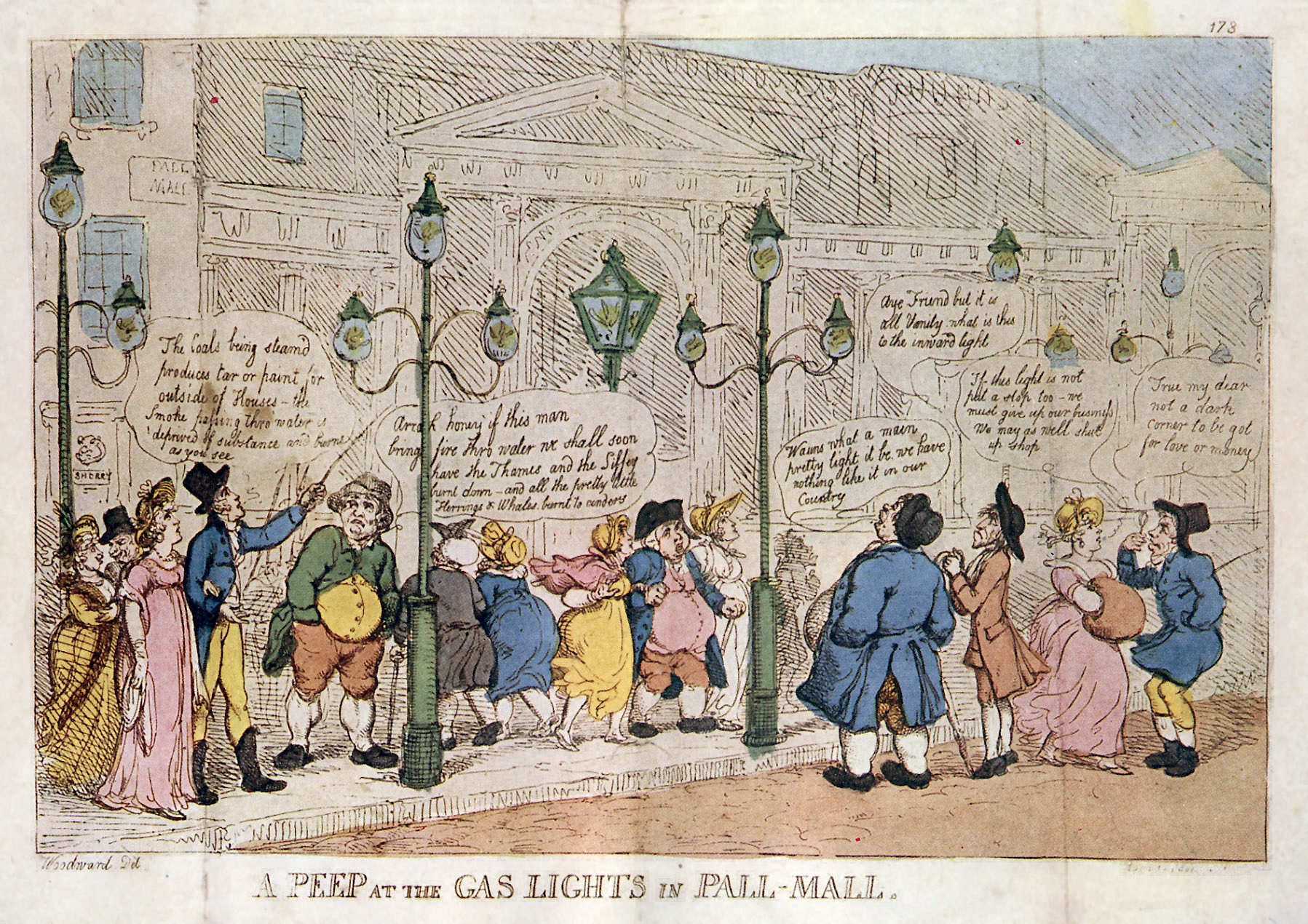
The first batch of gas street lamps, standing in King, Meeting, and Broad Streets, lit up the city during several successive evenings in late March 1848. The illumination was merely a test of the equipment, but it drew “quite a carnival crowd,” reported a local newspaper, as local residents sought “to investigate the effect of the new lights.”[15] The gas company commenced daily distribution to private customers and a handful of public lamps that April, after which members of City Council objected to the generous spacing between some of the new fixtures. Civic leaders recommended “that under no circumstances the distances should exceed one hundred and fifty feet apart,” which was approximately twice the distance between the old oil lamps. A protracted dispute ensued between the city and the gas company concerning the details of their contract, which retarded the municipal transition from oil to gas.[16]
The work of removing nearly two thousand cedar lampposts and installing approximately six hundred cast-iron replacements continued well into the summer of 1849. City Council employed just two white lamplighters instead of three during this time, a fact reflecting the diminishing number of oil lamps and the increasing number of gas lamps. The transition was evidently nearing completion in June 1849, when the Charleston Gas Light Company, now responsible for lighting all the street lamps, advertised to hire its own lamplighters, in accordance with its municipal contract.[17] The Gas Company and its several successors, operating under different names in later years, employed their own army of nightly lamplighters, about whom little information now survives.
The territory of the municipal corporation increased dramatically in 1850, when the City of Charleston annexed that part of the peninsula stretching from Calhoun Street northward to Mount Pleasant Street. The Gas Light Company thereafter built larger production facilities to keep pace with the growing demand from City Council and nearly every building in town. All of these factories produced significant volumes of pollutants, which first attracted the attention of City Council in the summer of 1851. That August, city officials began a long battle with the Gas Company over the volume of coal tar flowing through subterranean drains from their Church Street factory through Market Street and into the fish market on the east side of East Bay Street, which was effectively poisoned before the Civil War.[18]

Gas lamps illuminated the streets of urban Charleston nightly during the early part of the American Civil War, but the scarcity of Northern coal soon reduced the volume of gas, and the protracted Union bombardment of the city, which commenced in August 1863, discouraged City Council from illuminating targets for enemy artillery. Repairs to Charleston’s urban infrastructure, including the street lamps, commenced after the conclusion of the war in 1865, but the city’s poor finances retarded the pace of civic improvement for several generations.
Despite the continuation of hard times in the 1880s, some Charlestonians could not resist the opportunity to invest in the latest technology of the age. In the autumn of 1881, a group of local speculators partnered with Northern capitalists to form the United States Electric Illuminating Company of Charleston, South Carolina, which was essentially a satellite of a larger New York entity.[19] While the company’s finances coalesced during the ensuing winter, an unidentified agent furnished one or more electric arc lights for the annual floral exhibition of the Agricultural Society of South Carolina, held at their Agricultural Hall in Meeting Street in April 1882. That experiment did not prove entirely satisfactory, as one witness explained, “owing to the ghastly pallor which [the arc light] seems to impart to the complexion.”
The first public and positive exhibition of electric light in Charleston took place on 11 May 1882, when agents of the United States Electric Lighting Company of New York, at the request of local partners, erected a temporary display of lights at the Broad Street offices of the Charleston News and Courier. A single arc light illuminated the building’s street façade for several consecutive nights, but the main attraction was a string of fifteen incandescent lights distributed throughout the interior, powered by a portable two-horsepower steam generator. Witnesses who toured the illuminated space remarked that the incandescent bulbs produced a softer and more pleasing light than that of the more powerful arc lamp outside.[20]

Officers of the Electric Illuminating Company purchased property fronting both King and Queen Streets and in July 1882 commenced building Charleston’s first electric power plant at a site now identified as No. 94 Queen Street. The heart of the plant was a 100-horsepower tubular boiler—like a stationary steam locomotive—linked to a series of dynamos by belts and pullies.[21] The plant began producing electricity at the beginning of December 1882, by which time the company had sold both incandescent and arc-light fixtures to more than a dozen businesses along King and Meeting Streets. The electrical current traveled from the plant to customers along asbestos-covered wires suspended over the sidewalks by the same wooden poles used for the existing telegraph and telephone wires. While arc lights illuminated a few shop fronts in the city’s commercial district at that time, the only public place lighted by electricity during the winter of 1882–83 was Washington Square, behind City Hall, which featured one arc lamp raised forty feet above the center of the park.[22]
The urban network of mostly-indoor electric lights gradually expanded during the year 1883 to include various business, railroad depots, and roller skating rinks. Patrons frequenting these sites “declare that they would not be without it,” reported the News and Courier, “for in their opinion it is the cheapest, the brightest, and the best light that was ever invented.”[23] In mid-August 1883, the electric company erected a temporary line of arc lamps along King Street to illuminate the heart of the business district between Calhoun and Broad Streets. The experiment demonstrated that seven powerful arc lamps erected on poles standing three hundred yards apart provided greater illumination than the dirty old gas lamps, which were spaced approximately sixty yards apart. Officers of the electric company proudly declared that “electric light is really the only light for street lighting, both as regards the brilliancy of the illumination and the economy to the city.”[24]
Shortly after the municipal elections of November 1883, the new members of Charleston’s City Council began discussing the possibility of switching from gas to electric street lamps.[25] The city’s contract with the local gas company expired on the last day of 1883, and in January 1884 Council resolved to solicit bids for lighting the streets with either gas or electricity. Mayor William Courtenay famously declared that it was “about time that the city gave up the system of lighting the streets by Miller’s Almanac and the moon. The streets should be lighted thoroughly and lighted all night.” Another citizen opined that “There is no doubt whatever that the overwhelming majority of our people want this cheap and brilliant illumination. The only question now is, shall they be deprived of it in order to save the ‘useless lumber’ of the Gas Company?”[26]
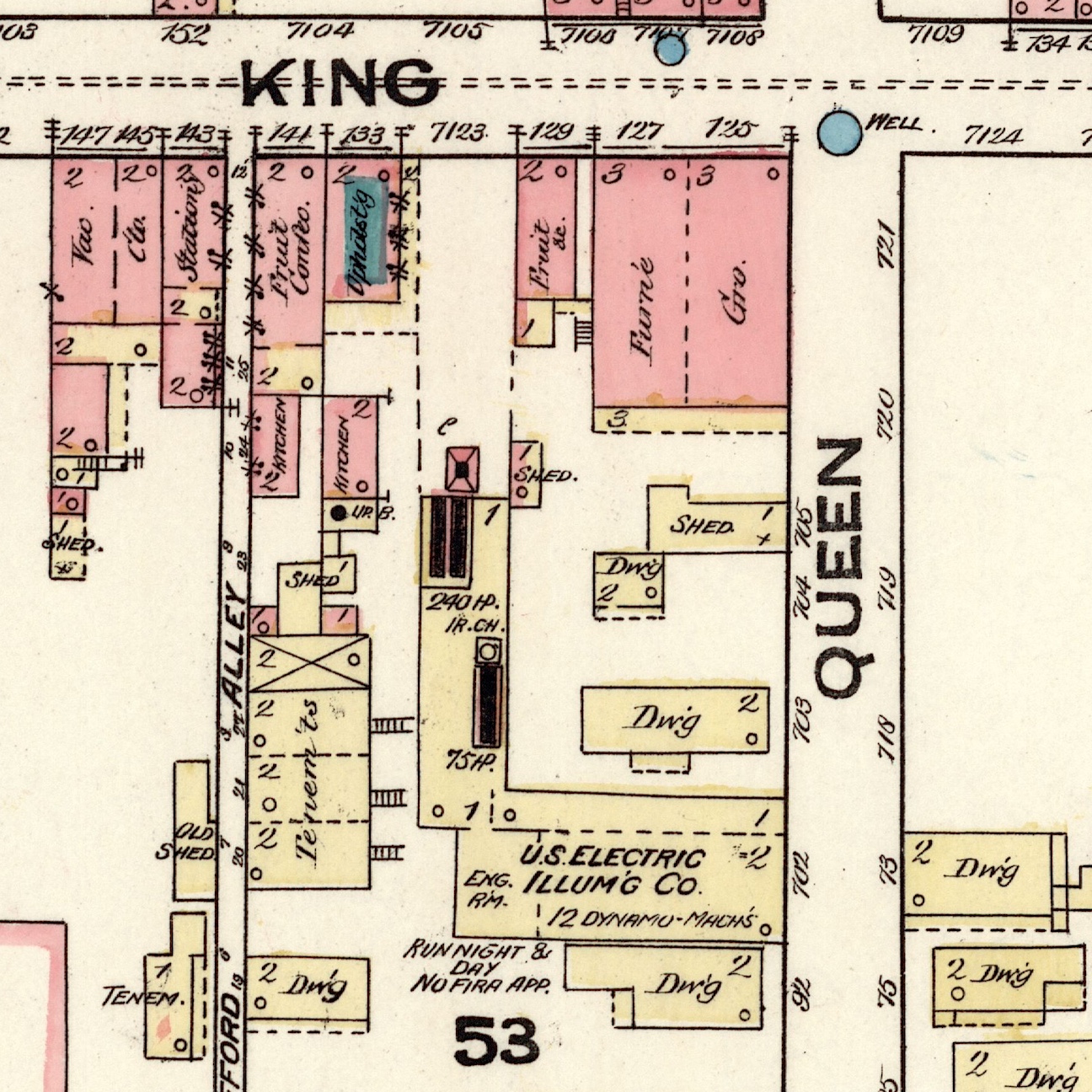
City Council published a request for bids in March 1884 for lighting the city streets with either 1,400 gas lamps or 200 electric arc lamps, plus indoor lighting for all municipal offices and market sheds.[27] After much discussion and negotiation, the members of Council resolved in April to split the contract between the two power plants. The city contracted for 640 gas lamps in the lower wards, south of Calhoun Street (the same number then in use in that region), and 90 electric arc lamps to light the upper wards from Calhoun Street to Mount Pleasant Street.[28] The new lights began burning in the upper wards on 1 June 1884, the first day of the year-long dual contract.
Seven months later, City Council began negotiating with agents of both the gas and electric companies to extend the existing contract for public lighting for another year. Both companies declined to continue the divided arrangement, however, so the city once again published a call for bids for lighting the city streets either by gas or electricity.[29] The resulting bids were too expensive, in the city’s judgment, so Council asked both companies in February 1885 to submit revised bids expressing their lowest price for a reduced quantity and quality of light burning for a reduced number of hours each night, still “following the moon” each month as in generations past. After much negotiating, the electric company declined to submit a revised bid, essentially throwing in the towel, while the gas company submitted a reduced bid that secured the contract. The members of City Council acknowledged that the electric lights were superior to the old gas lamps, but the city’s finances were simply too meager to sustain the novel amenity. As Mayor Courtenay lamented that May, “the experiment had been tried and the aggregate cost ascertained to be far beyond the means of the city to provide.”[30]
Prior to the termination of the dual contract for electric and gas street lamps on 1 June 1885, agents of the United States Electric Illuminating Company of Charleston notified customers that the pioneering business would cease operation on that date. Linemen removed the arc lamps and asbestos wires from the city streets in early June, while auctioneers sold the dismantled powerplant fronting Queen Street in July. After witnessing eighteen months of expanding electrical service in urban Charleston, customers public and private reverted to the familiar flame of manufactured gas.[31]
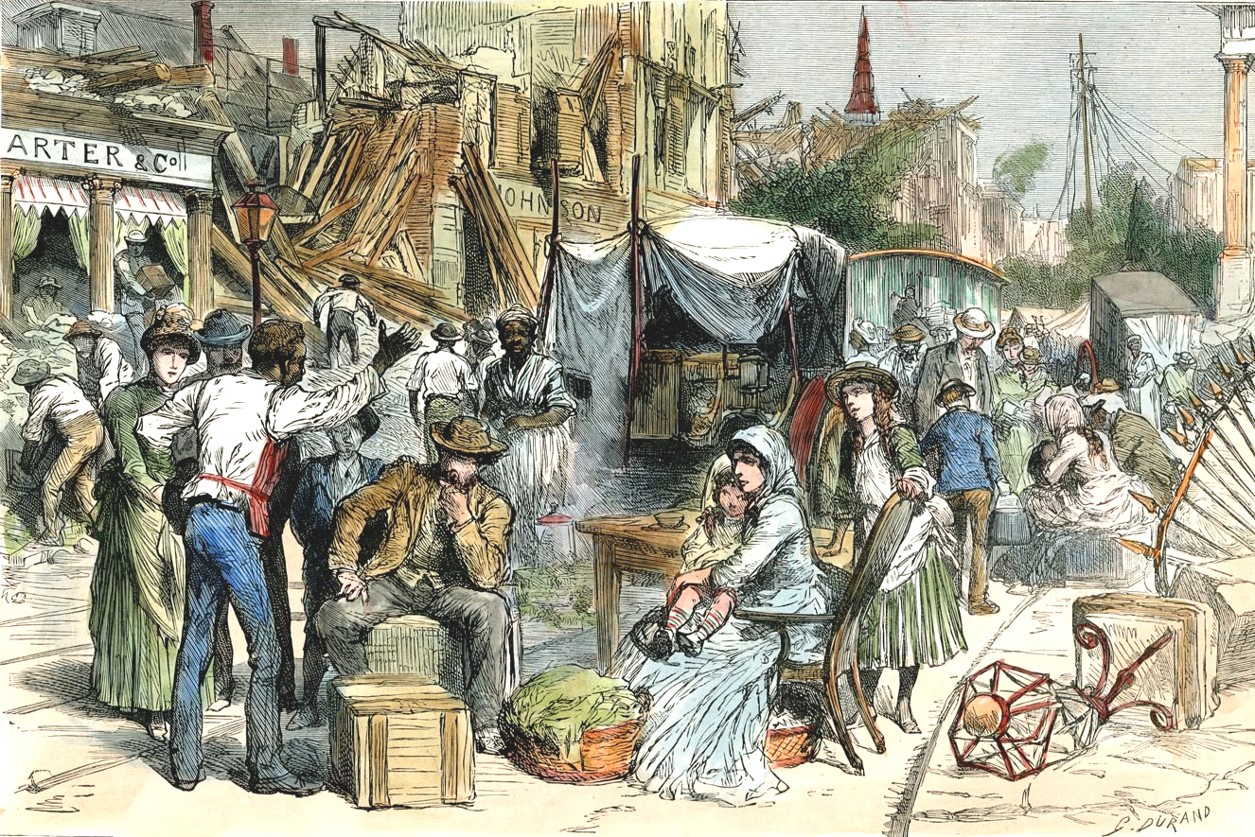
In the spring of 1886, a new entity called the Charleston Electric Light Company obtained a charter and commenced building a power plant extending between Pinckney and Hayne Streets, nearly opposite Maiden Lane. The massive earthquake of August 31st slowed its construction, but in December the company began courting subscribers for service in the spring.[32] At the same time, agents of the new electric company offered to contract with the city government to furnish electric lights for municipal buildings and the public streets. The renaissance of electric light in Charleston pleased the members of City Council, but they were reluctant to embark on another costly experiment with a company that had yet to generate a single watt of power. To encourage the industry and to lay the groundwork for future collaboration, however, Council resolved in December 1886 to contract with the new company for just twelve electric lamps—eight within the several market sheds in Market Street, three in Marion Square, and one in Washington Square. Those arc lights, switched on in the spring of 1887, marked the beginning of permanent electrification in the Palmetto City.[33]
From the spring of 1888 through the end of 1925, Charleston’s municipal government contracted annually for a gradually increasing number of electric street lamps and a gradually diminishing number of gas lamps. During that long transition, the corporate entities supplying the power evolved, consolidated, reorganized, and built larger production facilities distributed across the urban landscape.[34] Finally, in the spring of 1926, City Council resolved to delete the remaining 300 gas lamps from its annual budget, signaling the end of street illumination by manufactured gas in Charleston.[35]
“Natural gas” made its Lowcountry debut in 1954 and continues to supply heat and light to residences across Charleston County. As the slightly less-noxious cousin of manufactured gas, natural gas illumination fills a niche as a nostalgic substitute for the gas lamps of centuries past. The flickering flames encased in glass that you see on some Charleston residences today are certainly cleaner than the old coal-gas fixtures, but natural gas is still a non-renewable fuel that might or might not suit the goals of long-term sustainability in twenty-first century Charleston.[36]
Nocturnal light is a luxury that most modern folks consider indispensable. The past was a much darker place, however, and our forebears were thankful for any lamps to guide their steps, especially during the long nights of bleak midwinter. Lamplighters no longer walk our streets at sundown, but memories of their daily routine now fuel the time machine of our imaginations.
[1] South Carolina Department of Archives and History (hereafter SCDAH), Journal of the South Carolina Commons House of Assembly, No. 34 (1761–62), pages 67–68, 111–12 (7 and 28 May 1761). Wilson described his experiment with public lamps in a later advertisement in SCG, 16–23 April 1763, page 1.
[2] See the grand jury presentments of October 1767 (in South Carolina and American General Gazette (hereafter SCAGG), 30 October–6 November 1767, page 2), January 1768 (in SCAGG, 22–29 January 1768, page 2), January 1769 and April 1769 (in SCDAH, Criminal Journals (series 145002), 1769, pages 5, 42), and January 1770 (in South Carolina Gazette and Country Journal, 23 January 1770, page 2).
[3] SCDAH, Journal of the South Carolina Commons House of Assembly, No. 38 (1769–71), part 1, page 113 (4 August 1769).
[4] SCG, 29 March 1770, page 2; a similar, shorter story appears in SCAGG, 16–26 March 1770, page 2.
[5] SCDAH, Journal of the South Carolina Commons House of Assembly, No. 38 (1769–71), part 2, pages 340, 369 (22 and 31 March 1770).
[6] Act No. 993, “An Act for a Fish Market; and for Preserving the Lamps in Charlestown,” ratified on 7 April 1770, in David J. McCord, The Statutes at Large of South Carolina, volume 9 (Columbia, S.C.: A. S. Johnston, 1841), 705–8.
[7] See “An Ordinance for the preservation of the lamps of this city,” ratified on 6 November 1783, in Ordinances of the City Council of Charleston, In the State of South Carolina, Passed in the First Year of the Incorporation of the City (Charleston, S.C.: J. Miller, 1784), 17.
[8] Ross described himself as a “tinplateworker and lamplighter” in South Carolina Gazette and General Advertiser, 27 May 1784, page 1; the “Negro fellows” were advertised in State Gazette of South Carolina, 2 June 1791, page 1, “Sheriff’s Sales.”
[9] City Gazette, 17 October 1795, page 3, “Notice”; City Gazette, 16 April 1796, page 3, “Four Dollars Reward” (for Cato and “Little Tom”); City Gazette, 25 April 1796, page 3: “Ran Away, again.”
[10] The full text of “An Ordinance to provide for lighting the city lamps by contract, and for other purposes,” ratified on 5 January 1830, appears in Charleston Mercury, 11 January 1830, page 4.
[11] “An Ordinance to amend the ordinance relating to the lighting of City Lamps, and for other purposes,” ratified on 14 November 1839, in George B. Eckhard, comp., A Digest of the Ordinances of the City Council of Charleston, from the Year 1783 to October 1844 (Charleston, S.C.: Walker & Burke, 1844), 134.
[12] Proceedings of City Council, 6 August 1839, published in Charleston Courier, 10 August 1839, page 2.
[13] The full text of “An ordinance to promote the establishment of a gas company in the City of Charleston,” ratified on 6 March 1817, appears in Courier, 8 March 1817, page 2.
[14] Courier, 11 January 1847, page 2, “Lighting the City with Gas”; Proceedings of City Council, 3 May 1847, published in Courier, 5 May 1847, page 3; Proceedings of City Council, 1 June 1847, published in Courier, 3 June 1847, page 2; Courier, 8 February 1848, page 2: “Charleston Gas Light Company”; Courier, 16 March 1848, page 2, “The Gas Works”; Courier, 17 March 1848, page 2, “The Gas Works.”
[15] Southern Patriot, 31 March 1848, page 2, “Gas Lights”; Courier, 31 March 1848, page 2, “The Gas Works”;
[16] Proceedings of City Council, 16 May 1848, published in Southern Patriot, 18 May 1848, page 2; Proceedings of City Council, 31 May 1848, published in Southern Patriot, 2 June 1848, page 2; Proceedings of City Council, 21 June 1848, published in Southern Patriot, 22 June 1848, page 2; Proceedings of City Council, 22 August 1848, published in Southern Patriot, 25 August 1848, page 2; Proceedings of City Council, 31 August 1848, published in Southern Patriot, 1 September 1848, page 2; Proceedings of City Council, 26 September 1848, published in Southern Patriot, 28 September 1848, page 2.
[17] Proceedings of City Council, 14 October 1848, published in Courier, 16 October 1848, page 2; Proceedings of City Council, 17 October 1848, published in Courier, 16 October 1848, page 2; Courier, 4 June 1849, page 3, “Office Charleston Gas Light Company.”
[18] The earliest-known complaint about coal tar clogging the Market Street drain appears in the proceedings of City Council, 12 August 1851, published in Courier, 16 August 1851, page 2. Discussions of the same topic appear in the printed texts of numerous council meetings during the several subsequent years.
[19] Charleston News and Courier (hereafter CNC), 5 September 1881, page 3, “Notice.—At the next session of the General Assembly of South Carolina application will be made for a charter incorporating ‘The Electric Illuminating Company of South Carolina.”
[20] CNC, 12 May 1882, page 1, “The Incandescent Light. First Display of the Electric Lamps In the South.”
[21] See the description of the plant in CNC, 25 July 1882, page 4, “Electric Light for Charleston.”
[22] CNC, 6 December 1882, page 4, “The Bright Electric Light.”
[23] CNC, 30 January 1884, page 1, “The Brightest and the Best.”
[24] CNC, 15 August 1883, page 1, “The Light of the Future”; the preferred distance between the gas lamps is mentioned in the Proceedings of City Council, 25 March 1885, published in CNC, 27 March 1884, page 3.
[25] CNC, 15 December 1883, page 1, “Lighting the City.”
[26] CNC, 3 March 1884, page 1, “Lighting the City.” Miller’s Almanac was published in Charleston every year from 1817 to 1894.
[27] CNC, 5 March 1884, page 2, “Proposals Invited. Estimates for Lighting the City.”
[28] See the Proceedings of City Council, 25 March, 3 April, and 8 April 1884, published in CNC, 27 March, 8 April, 9 April 1884.
[29] CNC, 14 January 1885, page 1, “The Loaves and Fishes,” Proceedings of City Council, 27 January 1885, published in CNC, 30 January 1885, page 3; CNC, 14 February 1885, page 3, “City of Charleston, S.C.”
[30] See the Proceedings of City Council, 24 February, 24 March, and 26 May 1885, published in CNC, 26 February, 26 March, and 29 May 1885, page 3.
[31] CNC, 23 May 1885, page 8, “The Last of the Electric Light Company”; CNC, 2 June 1885, page 8, “The Electric Light Put Out”; CNC, 10 June 1885, page 8, “Odds and Ends”; CNC, 26 June 1885, page 5, “Auction Sale of Land and Buildings, Machinery and Electrical Apparatus”; CNC, 8 July 1885, page 8, “The Last of the Electric Light.”
[32] CNC, 23 January 1886, page 8, “The Electric Light Again”; CNC, 10 March 1886, page 8, “The Electric Light”; Proceedings of City Council, 11 May 1886, published in CNC, 13 May 1886, page 3; CNC, 20 July 1886, page 8, “The Electric Light Again”; CNC, 31 October 1886, page 8, “All About Town.”
[33] Proceedings of City Council, 14 December 1886, published in CNC, 18 December 1886, page 9; CNC, 29 December 1886, page 1, “Taxlayers and Taxpayers”; CNC, 30 December 1886, page 8, “Lighting the City.”
[34] For more information about the corporate evolutions and the physical plants, see Nell C. Pogue, South Carolina Electric & Gas Company 1846–1964 (Columbia: South Carolina Electric & Gas Company, 1964).
[35] Charleston Evening Post, 13 January 1926, page 11, “1926 Appropriations Bill For City Given [to] Council.”
[36] For a brief review of the introduction of natural gas to Charleston, see Pogue, South Carolina Electric & Gas Company 1846–1964, 154–60.
NEXT: The Orange Economy of Colonial Charleston
PREVIOUSLY: Giving Thanks for Native American Food in 1670 Charleston
See more from Charleston Time Machine

